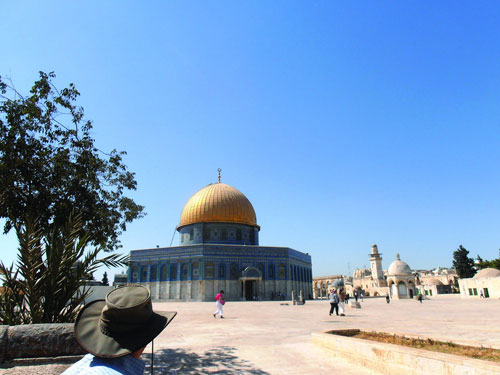.jpg)
.jpg)
(Jerusalem, Israel)—Jerusalem, the ancient capital of Israel, has a comfortable and familiar sensation that leaves all who are there feeling at home whether they actually live there or are just visiting. There are many sites that are essential stops on any visit to Jerusalem, such as the Western Wall, the YadVashem Holocaust Memorial, the Mahane Yehuda market, and many more. However, as time has gone on, this ancient city has also developed new sites, some of which are relatively new, and some of which the most ancient of all. These places, aside from being less crowded and busy than more mainstream sites, help give a new and exciting feel to a city that has changed minimally over the past few decades.
.jpg)
As the summer begins and American tourists start to flock to the Holy Land, the JLBC has compiled some suggestions of these “off the beaten path” sites, to help visitors to Jerusalem experience some of its most unique places while there.
.jpg)
THE TEMPLE MOUNT (HAR HA BAYIT)- Old City, Jerusalem
The Temple Mount, aside from being the holiest spot in Judaism as the site of the first two Temples, is also one of the most contested pieces of land in the country and one of the biggest contemporary halakha issues in modern Judaism. This 150,000 square meter (about 36 acre) piece of land was taken over by the IDF after the 1967 Six Day War, and then day-to-day control was subsequently given to the Jerusalem Islamic Waqf. Until recently, the Waqf has made it very difficult for Jewish visitors to get onto the mountain, but now it has become more prevalent for Jews to visit, albeit during special hours and as long as they follow the special rules of the Waqf. Even Israeli dignitaries have taken to going up to Har Ha Bayit on a consistent basis. From a halakha perspective, many Modern Orthodox rabbis permit ascent to the Temple Mount as long as the holiest places are avoided, and most tour guides will know where to go and where not to go on the Mount.
Arranging a visit:The regular Jewish visiting hours are 07:30-12:30 and 13:30-15:00 all days except Fridays and Islamic holidays.All are reminded to visit the mikvah before their visit and bring their passport with them. All visitors report to the ramp at the lower entrance to the Western Wall with identification, where they will be assigned an Israeli police and Waqf escort for their time on the Mount. For more information on visiting Temple Mount, contact Machon Hamikdash (The Temple Institute) on the web at www.templeinstitute.org. Don’t forget to ask your local orthodox rabbi before visiting.
TEDDY KOLLEK PARK (PARK TEDDY)- Hativat Yerushalayim St. at Derech Hevron, Jerusalem (close to Jaffa Gate)
Teddy Kollek Park, located in the Mitchell Gardens at the southwest corner of the Old City walls near the Sultan’s Pool, recently reopened as a beautiful new park in the center of Jerusalem and as a testament to the work of the former mayor of Jerusalem. The new park centers around the Hassenfield Family Fountain, a computerized water feature which, combining 256 water hoses with an original light and music show, puts Jerusalem on par with similar attractions in Singapore, Geneva, Prague and Barcelona, and promises to be a dazzling nighttime spectacle for the entire family. The park also includes the Kenneth and Ann Bialkin Visitors’ Center, where guests can explore the story of Jerusalem’s growth under Kollek’s tenure through a 3D film collection, as well as a model sun dial, wishing well, and many other installations which diversify the attraction of the park. Park Teddy’s centralized location, right on the border between the center of town, the Old City, and the southern parts of Jerusalem, makes it worth a visit for visitors from all parts of the city, whether to appreciate its beauty during the day or watch the sound and lights show at night.
Getting There: Teddy Kollek Park is a 10-minute walk from the City Hall (KikarSafra) station on the Jerusalem Light Rail, and is also easily accessible by foot from the David Hamelech and KerenHayesod hotel districts.
By Tzvi Silver













